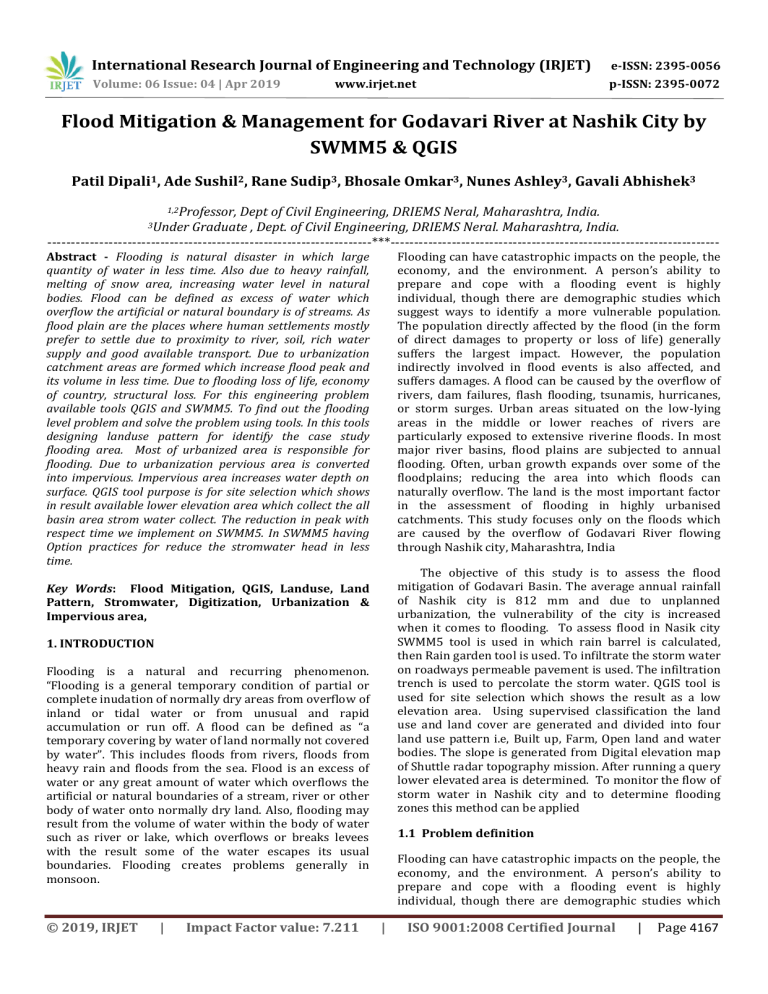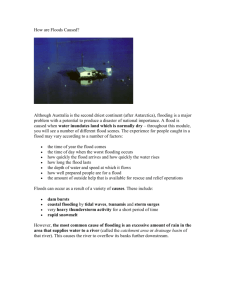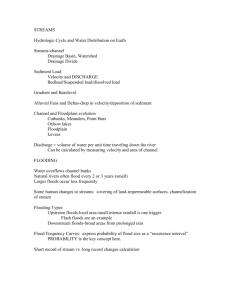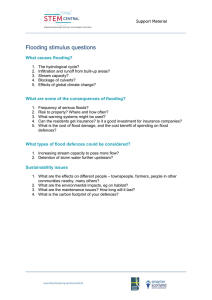IRJET- Flood Mitigation & Management for Godavari River at Nashik City by SWMM5 & QGIS
advertisement

International Research Journal of Engineering and Technology (IRJET) e-ISSN: 2395-0056 Volume: 06 Issue: 04 | Apr 2019 p-ISSN: 2395-0072 www.irjet.net Flood Mitigation & Management for Godavari River at Nashik City by SWMM5 & QGIS Patil Dipali1, Ade Sushil2, Rane Sudip3, Bhosale Omkar3, Nunes Ashley3, Gavali Abhishek3 1,2Professor, Dept of Civil Engineering, DRIEMS Neral, Maharashtra, India. Graduate , Dept. of Civil Engineering, DRIEMS Neral. Maharashtra, India. ---------------------------------------------------------------------***---------------------------------------------------------------------3Under Abstract - Flooding is natural disaster in which large quantity of water in less time. Also due to heavy rainfall, melting of snow area, increasing water level in natural bodies. Flood can be defined as excess of water which overflow the artificial or natural boundary is of streams. As flood plain are the places where human settlements mostly prefer to settle due to proximity to river, soil, rich water supply and good available transport. Due to urbanization catchment areas are formed which increase flood peak and its volume in less time. Due to flooding loss of life, economy of country, structural loss. For this engineering problem available tools QGIS and SWMM5. To find out the flooding level problem and solve the problem using tools. In this tools designing landuse pattern for identify the case study flooding area. Most of urbanized area is responsible for flooding. Due to urbanization pervious area is converted into impervious. Impervious area increases water depth on surface. QGIS tool purpose is for site selection which shows in result available lower elevation area which collect the all basin area strom water collect. The reduction in peak with respect time we implement on SWMM5. In SWMM5 having Option practices for reduce the stromwater head in less time. Flooding can have catastrophic impacts on the people, the economy, and the environment. A person’s ability to prepare and cope with a flooding event is highly individual, though there are demographic studies which suggest ways to identify a more vulnerable population. The population directly affected by the flood (in the form of direct damages to property or loss of life) generally suffers the largest impact. However, the population indirectly involved in flood events is also affected, and suffers damages. A flood can be caused by the overflow of rivers, dam failures, flash flooding, tsunamis, hurricanes, or storm surges. Urban areas situated on the low-lying areas in the middle or lower reaches of rivers are particularly exposed to extensive riverine floods. In most major river basins, flood plains are subjected to annual flooding. Often, urban growth expands over some of the floodplains; reducing the area into which floods can naturally overflow. The land is the most important factor in the assessment of flooding in highly urbanised catchments. This study focuses only on the floods which are caused by the overflow of Godavari River flowing through Nashik city, Maharashtra, India The objective of this study is to assess the flood mitigation of Godavari Basin. The average annual rainfall of Nashik city is 812 mm and due to unplanned urbanization, the vulnerability of the city is increased when it comes to flooding. To assess flood in Nasik city SWMM5 tool is used in which rain barrel is calculated, then Rain garden tool is used. To infiltrate the storm water on roadways permeable pavement is used. The infiltration trench is used to percolate the storm water. QGIS tool is used for site selection which shows the result as a low elevation area. Using supervised classification the land use and land cover are generated and divided into four land use pattern i.e, Built up, Farm, Open land and water bodies. The slope is generated from Digital elevation map of Shuttle radar topography mission. After running a query lower elevated area is determined. To monitor the flow of storm water in Nashik city and to determine flooding zones this method can be applied Key Words: Flood Mitigation, QGIS, Landuse, Land Pattern, Stromwater, Digitization, Urbanization & Impervious area, 1. INTRODUCTION Flooding is a natural and recurring phenomenon. “Flooding is a general temporary condition of partial or complete inudation of normally dry areas from overflow of inland or tidal water or from unusual and rapid accumulation or run off. A flood can be defined as “a temporary covering by water of land normally not covered by water”. This includes floods from rivers, floods from heavy rain and floods from the sea. Flood is an excess of water or any great amount of water which overflows the artificial or natural boundaries of a stream, river or other body of water onto normally dry land. Also, flooding may result from the volume of water within the body of water such as river or lake, which overflows or breaks levees with the result some of the water escapes its usual boundaries. Flooding creates problems generally in monsoon. © 2019, IRJET | Impact Factor value: 7.211 1.1 Problem definition Flooding can have catastrophic impacts on the people, the economy, and the environment. A person’s ability to prepare and cope with a flooding event is highly individual, though there are demographic studies which | ISO 9001:2008 Certified Journal | Page 4167 International Research Journal of Engineering and Technology (IRJET) e-ISSN: 2395-0056 Volume: 06 Issue: 04 | Apr 2019 p-ISSN: 2395-0072 www.irjet.net suggest ways to identify a more vulnerable population. The population directly affected by the flood (in the form of direct damages to property or loss of life) generally suffers the largest impact. However, the population indirectly involved in flood events is also affected, and suffers damages. A flood can be caused by the overflow of rivers, dam failures, flash flooding, tsunamis, hurricanes, or storm surges. Urban areas situated on the low-lying areas in the middle or lower reaches of rivers are particularly exposed to extensive riverine floods. In most major river basins, flood plains are subjected to annual flooding. Often, urban growth expands over some of the floodplains; reducing the area into which floods can naturally overflow. The land is the most important factor in the assessment of flooding in highly urbanised catchments. This study focuses only on the floods which are caused by the overflow of Godavari River flowing through Nashik city, Maharashtra, India 1.2 OBJECTIVES The main objective of study is, ● ● ● ● ● To provide proper mitigation to the study area by using SWMM5 and QGIS To develop flood exposure map by integrating the land use and flood map data by using QGIS To know long term simulation of water runoff quantity and quality by using SWMM5 To know the hydrological components by collecting sub catchment area divided into impervious and pervious area with the help of SWMM5. Flood plain mapping of natural channel systems. 2. PROJECT DATA high tide level exceeds significantly. This leads to vulnerable population (APFM, 2008). 2.1 Causes of floods The flooding can be caused by natural as well as anthropogenic activities. Factors causing flooding are mainly meteorological, hydrogical and human factors & are shown in table 2.1 Meteorological Factors Table -1: 2.2 Flood management measures Flood management covers the holistic and continuous assessment, evaluation and reduction of flood hazard and flood risks. The objectives of flood management measures are as below, Floods are the naturally occurring event and hence cannot be prevented and they can have serious consequences such as displacement of people and damage to the environment Floods can also be caused by anthropogenic activities and human interventions in the natural processes such as increase in settlement areas, population growth and economic assets over low lying plains prone to flooding 1) To prevent the further build-up of risks through appropriate and risk- conscious development (i.e. Development in safe places, appropriate forms of construction etc.) 2) To reduce existing risks through preventive and preparedness measures (eg. construction of flood dikes and implementation of early warning systems) 3)To adapt to changing risk factors (climate change adaptation). At around 2006 the global population living in cities exceeded for the first time in history the global rural population. The number of people living within 1 meter of | Impact Factor value: 7.211 Human Factors ● Rainfall ● Soil ● Soil moisture level ● Cyclonic storms moisture level ● Temperature ● Ground water ● Ground water level prior to level prior to ● Snowfall storm storm /snowmelt ● Natural surface ● Natural surface infiltration rate infiltration rate ● Presence of ● Presence of impervious impervious cover cover ● Channel cross● Channel crosssectional slope & sectional slope & roughness roughness ● Presence or absence of over ● Presence or absence of over bank flow, bank flow, channel network channel network ● High tide ● High tide impeding impeding drainage drainage The increase in population density and rapid urbanization, increases impervious surfaces and thus exert a significant influence on hydrological processes in an urban area, thus this leads to flooding problems. Flood causes extensive loss of life and properties. Modification of the land surface during urbanization alters the storm water runoff characteristics such as pervious and impervious surfaces. © 2019, IRJET Hydrological Factors Flood risk:- Flood risk is the product of hazard, i.e .the physical and statistical aspects of | ISO 9001:2008 Certified Journal | Page 4168 International Research Journal of Engineering and Technology (IRJET) e-ISSN: 2395-0056 Volume: 06 Issue: 04 | Apr 2019 p-ISSN: 2395-0072 www.irjet.net the actual flooding (e.g. return period of the flood, extent and depth of inundation), and the vulnerability, i.e., the exposure of people and assets to floods and the susceptibility of the elements at risk to suffer from flood damage (European Commission, 2007).Flood risk is defined as combination of potential damage and probability of flooding. For this reason rainfall run-off has to be computed to know the discharge carried by the river channel due to the current rainfall. Due to this rainfall runoff modelling required. 3.1 Quantum Geographical Information System Quantum Geographical Information System (QGIS) is an open source geographic information system. Quantum Geographical Information System (QGIS) aims to be a user friendly geographic information system (GIS), providing common functions and features. The initial goal of the project was to provide a geographical information system (GIS) data viewer. Quantum Geographical Information System (QGIS) has reached the point in its evolution where it is being used by many for their daily Geographical Information System (GIS) data viewing needs. Quantum Geographical Information System (QGIS) supports a number of raster and vector data formats. 2.3 GIS and tools A Geographic information system is a computer based system capable of capturing, storing, and analysis and displaying geographically referenced information; that identified according to location. GIS is a computer assisted system with a set of processes executed on raw spatial data to produce information. The GIS is a tool for effective presentation and processing of spatial information. GIS is a decision support system involving the integration of spatially referenced data in a problem solving environment. The spatial data can be in two different data models: Vector (points, line, polygons) and Raster (grid based).In the present study GIS is used as a tool for spatial data management, analysis and visualization. The combination of spatial data with various available statistical information in GIS provides the support to decision makers for improved planning of community growth. Digitization Digitizing is one of the most common tasks that a GIS Specialist has to do. Often a large amount of ‘GIS time’ is spent in digitizing raster data to create vector layers that you use in analysis. Quantum GIS has powerful capabilities to digitize raster data. In this study taken some high resolution satellite imagery and digitize it to create a vector polygon layer. 2.4 Hydrological Model Stormwater Management Model (SWMM) is a physically based, discrete-time simulation model. It applies principles of conservation of mass, energy, and momentum wherever applicable. This section briefly describes the methods Stormwater Management Model (SWMM) uses to model storm-water runoff quantity and quality through the following physical processes: The programmed features a completely integrated work environment including a database, data entry utilities, a computation engine and result reporting tools. Raster Mediation is an informal process where the parties are assisted by one or more neutral third parties in their efforts towards settlements. Mediators do not judge or arbitrate the dispute, mediators advised the parties to assist in bringing about a mutually acceptable solution. The mediators have no power to impose an outcome on disputing parties. Mediation is the involvement of an external professional, or mediator, to establish an environment conducive to communication and problem solving between conflicting parties. Including a trained professional to conduct and lead negotiations creates not only a forum for better communication, but also fosters a greater understanding on both sides. 3. METHODOLOGY AND RESULTS Assessment of flood exposure has been done by combining existing methodologies and some innovative procedures. This section provides introduction to methodologies used in the study and the discussion on evaluation of non-structural flood management measures. For development of methodology data such as discharge from flood simulation model is required. Then this discharge data along with land use data and river morphology are inputs to the mapping tool (QGIS). Rainfall runoff plays important role in surface urban flooding. The runoff data describes the characteristics of the ground surfaces in the system, and the rainfall-runoff model which is used for each. This lets us know how much of the rainfall falling on the catchment area becomes runoff and at what rate does it enters the drainage system. © 2019, IRJET | Impact Factor value: 7.211 Landuse data In the event of flood the area on both the banks of river gets inundated. So the settlements on the river banks get suffered. For urbanised catchment the land use data varies from location to location. Landuse pattern is the important component of flood exposure, so it is essential to analyse tithe land use at the location may consists of residential buildings, slums, open plots, farm lands, institutions etc. The land use data is input for QGIS | ISO 9001:2008 Certified Journal | Page 4169 International Research Journal of Engineering and Technology (IRJET) e-ISSN: 2395-0056 Volume: 06 Issue: 04 | Apr 2019 p-ISSN: 2395-0072 www.irjet.net determine the amount of impervious area and Manning roughness coefficients for each catchment, which will then use by Stormwater Management Model (SWMM) to calculate the total runoff flow. The directly connected impervious area is the amount of impervious area that is directly connected to a sewer system or water body. Stormwater Management Model (SWMM) uses the directly connected impervious area rather than the total impervious area in a subcatchment. 3.2 Rainfall-Runoff modelling software (SWMM.5) The Storm Water Management Model (SWMM) is a dynamic rainfall-run off simulation model used for single event or long-term (continuous) simulation of run off quantity and quality from primarily urban areas. The run off component of SWMM operates on a collection of sub catchment areas that receive precipitation and generate run off and pollutant loads. The routing portion of SWMM transports this run off through a system of pipes, channels, storage/treatment devices, pumps and regulators. SWMM tracks the quantity and quality of run off generated within each sub-catchment and the flow rate, flow depth and quality of water in each pipe and channel during a simulation period comprised of multiple time steps. 3.2 RESULT DISCUSSION Simulation by Using Strom water Management Model The Godavari River subcatchment modelled for the rainfall event of 13th July 2009 to 15th July 2009 by using Strom water Management Model (SWMM). From that water depth of the river can be simulated. It was observed that the peak water depth at powai site is about 0.8m. The following figure (3.1) shows the simulation of depth by using Stromwater Management Model (SWMM). SWMM was first invented in 1971 and there were many different and major upgrades done to it . This latest rewrite of SWMM was produced by the Water Supply and Water Resources Division of the U.S. Environmental Protection Agency's (EPA) National Risk Management Research Laboratory with assistance from the consulting firm of CDM, Inc. Applications of Storm water management model (SWMM) 1) Design and sizing of drainage system components for flood control 2) Sizing of detention facilities and their appurtenances for flood control quality protection. 3) Flood plain mapping of natural channel systems Catchment FIG NO. 3.1 without ILD Method A catchment basin is an extend or an area of land where all surface water from rain, melting snow converges to single point at lower elevation, usually the exit of the basin, where the water join to a another body of water, such as river, lake and ocean. A drainage basin or catchment basin is an extent or an area of land where all surface water from rain, melting snow converges to a single point at a lower elevation, usually the exit of the basin, where the waters join another body of water, such as river, lake, reservoir, estuary, wetland, sea, or ocean. Case 1: Implementation of Rain Garden The depth simulation after the implementation of Rain garden as a BMP on open area by using SWMM software. Land Use Land uses are categories of development activities or land surface characteristics assigned to subcatchments. The Stormwater Management Model (SWMM) user has many options for defining land uses and assigning them to subcatchment areas. Current land uses represent a combination of urbanized, open ground, grassy, and forest types it varying by subcatchment to sub-catchment. Stormwater Management Model (SWMM) used land use percentages directly to calculate the runoff hydrograph within a catchment. Land use percentages are also used to © 2019, IRJET | Impact Factor value: 7.211 fig3.2 : with providing ILD 3.3: Summary The present model is used to simulate the rainfall runoff process in the Mithi river catchment. The model developed | ISO 9001:2008 Certified Journal | Page 4170 International Research Journal of Engineering and Technology (IRJET) e-ISSN: 2395-0056 Volume: 06 Issue: 04 | Apr 2019 p-ISSN: 2395-0072 www.irjet.net in Stormwater Management Model (SWMM 5.1) software. The input data is collected by using automatic weather station. The model is simulates the one-minute interval rainfall data in the selected study catchment and observed hourly water depth data for 13th July 2009 to 15th July 2009 period. The current study represents methodology of modelling of urban flow using public domain software such as Stormwater Management Model Upgrading Using rain gardens. Site Selection in Thessaloniki, Greece” Sciencedirect Elsvier Agriculture and Agricultural Science Procedia 4 Pg. No. 338 – 347 [3] Marcio H. Giacomoni, Emily M. Zechman and Kelly Brumbelow (2012), “ Hydrological Footprint Residence: Environmentally friendly Criteria for Best Management Practices” Journal of Hydrologic Engineering ASCE, Pg. No. 99-108 Model is prepared by using Quantum Geographic Information System (QGIS 14.2.0) software, the land use pattern is digitised. That land use pattern vector file is converted into raster map. Raster map shows the suitable area for applying Best Management Practices (BMP’s). The Best Management Practices (BMP’s) applied on the basis of available area, elevation and slope [4] Maya P. Abi Aad, Makram T. Suidan and William D. Shuster (2010), “Modelling Technique od Best Management Practices: Rain Barrel and Rain Garden Using EPA SWMM-5” Journal of Hydrologic Engineering ASCE, Pg. No. 434-443 5] M. J. Braune and A. Wood (1999) “Best Management Practices Applied To Urban Runoff Quantity and Quality” ElsevierScience Ltd on behalf of the IAWQ Waf. Sci. Tech. Vol. 39, No. 12, Pg. 117-121. 3.4. Conclusion: The Stormwater Management Model (SWMM 5.1) model have been used by using various site selection criteria to demonstrate the simulation of water surface depth at Mithi river subcatchment. The water depth has been obtained at Powai site with and without considering the effect of Best Management Practices (BMP’s). Four cases are taken for site selection for applying Best Management Practices (BMP’s) implementation such as rain garden for open area, rain barrel for the urban area, infiltration trenches for the open area, permeable pavement for the road area and combination of all these techniques are applied in model and from that it is concluded that urban area is most suitable for applying rain barrel system give the minimum water depth as compare to others. The methodology is developed by using Quantum Geographic Information System (QGIS) model shows the perfect suitable site location for applying Best Management Practices (BMP’s). The contour shows the elevation. In case study area, urbanised area is maximum available spacing for applying Best Management Practices (BMP’s) for rain barrel. Finally it is concluded that rain barrel system is most suitable with compare to other techniques. In other techniques there is limitation in stormwater holding capacity because it is purely depend on water table level of that particular area. Decreasing capacity of soil to hold stormwater may lead to increase in flood level. In rain barrel system we can provide number of rain barrels and can increase the storing capacity to mitigate the flood. [6] Nivedita G Gogate and Pratap M Rawal (2012),” Int. Conf. on Advances in Design and Construction of Structures ‘’ ASCE Pg. No. 132-140 REFERENCES [1] Aaron A. Jennings, Ata A. Adeel, Alex Hopkins, Alexandra L. Litofsky & Steven Wellstead (2013), Rain Barrel Urban Stormwater Management Performance”, ASCE Pg. No. 757-765 [2] K. L. Katsifarakis, M. Vafeiadis and N. Theodossiou (2015), “Sustainable Drainage and Urban Landscape © 2019, IRJET | Impact Factor value: 7.211 | ISO 9001:2008 Certified Journal | Page 4171





